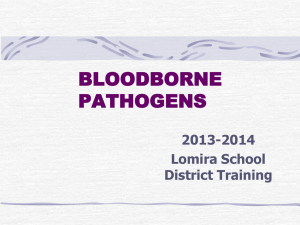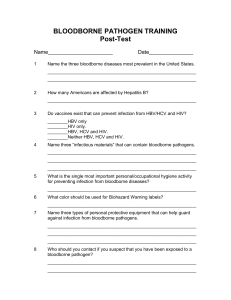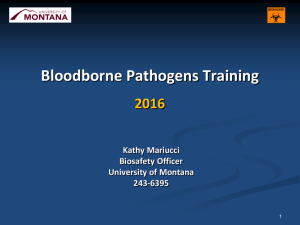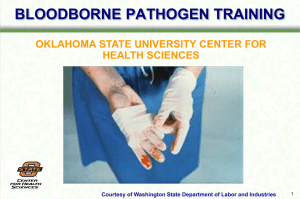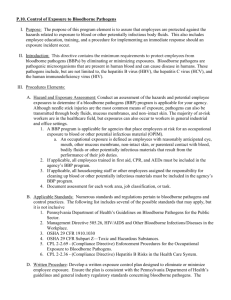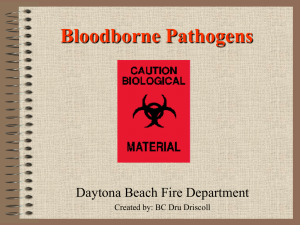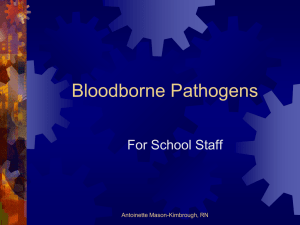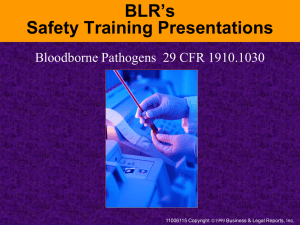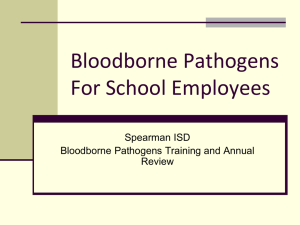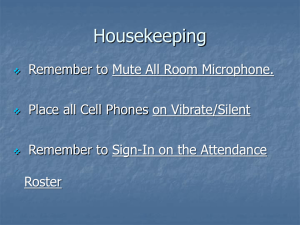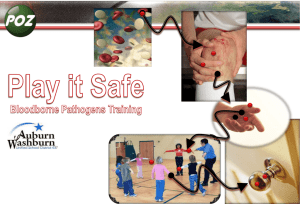Bloodborne Pathogens
advertisement
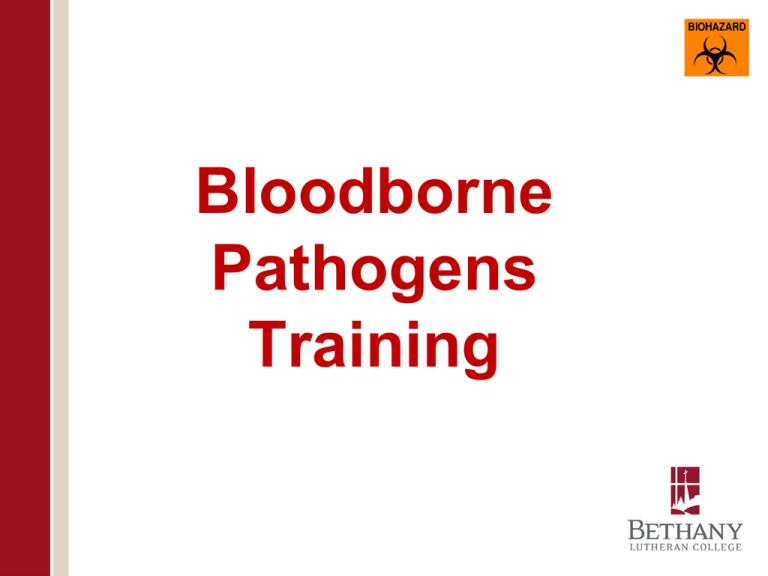
Bloodborne Pathogens Training OSHA’S Bloodborne Pathogen Standard 29CFR 1910.1030 Employers must: • Develop an Exposure Control Plan (ECP) that details their Bloodborne Pathogens (BBP) Program • Provide employees at risk with hepatitis B vaccination • Provide initial and annual training for safe handling of BBP • Supply and maintain personal protective equipment • Provide post-exposure evaluation and follow-up to employees who have an accidental exposure Topics to be Covered • What are bloodborne pathogens? • Safe work practices • Decontamination and cleanup • Proper actions to take in the event of an accidental exposure WHAT ARE BLOODBORNE PATHOGENS? Bloodborne Pathogens • Bloodborne pathogens are microorganisms present in human blood that can infect and cause disease in people who are exposed to blood containing the pathogen • These pathogens include, but are not limited to, human immunodeficiency virus (HIV) and hepatitis B virus (HBV). Other Potentially Infectious Material (OPIM) • The following human fluids are considered potentially infectious: – – – – – – – – – – Semen Vaginal Secretions Cerebrospinal Fluid Pleural Fluid Pericardial Fluid Peritoneal Fluid Amniotic Fluid Saliva in dental procedures Any body fluid visibly contaminated with blood All body fluids when it is difficult or impossible to differentiate between body fluids Common Examples of Bloodborne Pathogens • Viruses: • Hepatitis B Virus (HBV) • Hepatitis C Virus (HCV) • Human Immunodeficiency Virus (HIV) Hepatitis B Virus (HBV) • Causes inflammation of the liver • Can survive outside of the body up to 7 days! • ~60,000 people are infected annually as reported by Centers for Disease Control and Prevention (CDC) • 1.2 million Americans chronically infected with HBV (per CDC) • 2/3 of infected people become symptomatic • Symptoms – Fatigue – Stomach pain – Loss of appetite – Nausea – Jaundice (yellowing of skin) Hepatitis B Vaccine Available • Vaccine protects people from HBV infection with a 95% effectiveness • HBV vaccination is given in three doses • Possible side effects of vaccination • Pain, itching, swelling at site of injection • Flu-like symptoms • Allergic reaction to the yeast component of the vaccine Hepatitis B Vaccination at BLC • You can decline to be vaccinated or you can be vaccinated at a later date • Employees • Vaccination for employees is provided at no charge! Hepatitis C Virus (HCV) • Like HBV, HCV causes liver inflammation • Risk factor: Direct blood-to-blood contact • ~25,000 Americans are infected annually • ~3.2 million Americans are chronically infected with HCV • Only 20 % of people infected with HCV become symptomatic • All the symptoms of HBV • Dark urine • Chronic HCV infection can lead to either cirrhosis or cancer of the liver • About 25% of people infected with HIV are also infected with HCV Treatment for Hepatitis C Infection • There is no vaccine for Hepatitis C (HCV) • There are antiviral drug treatments • Ribavirin • Interferon • Relapse is common after withdrawal of drug treatment • 4 out of 10 people treated successfully eliminate virus Human Immunodeficiency Virus (HIV) • Approximately 40,000 Americans are infected each year • HIV is not as easily contracted as HBV • Approximately 1 in 250 people exposed will become infected • Nearly 25% of HIV positive people also have HCV Human Immunodeficiency Virus (HIV) • There is no vaccine for HIV • Causes AIDS • May show no signs or symptoms for up to 10 years or longer • Once AIDS develops, the person can contract the following: – Fungal infections of the mouth and esophagus – Unusual cancers – Pneumonia SAFE WORK PRACTICES BLC Bloodborne Pathogens Exposure Control Plan (ECP) • Five fundamental components of an ECP: • 1) Exposure Determination • 2) Methods of Compliance • 3) Hepatitis B Vaccination • 4) Communication of Hazards • 5) Post Exposure Evaluation and Follow Up Definitions: • Engineering Controls – Objects used in the workplace that isolate or remove a hazard, reducing the risk of exposure • Work Practice Controls – Methods of working that reduce the likelihood of an exposure incident by changing the way the task is carried out • Universal Precautions: – Infection control guidelines designed to protect workers from exposure to diseases spread by blood and certain body fluids Exposure Incident: • Accidental puncture with needle, glass, scalpel or other sharps contaminated with the pathogen • Contact between broken or damaged skin and infected body fluids • Contact between mucous membrane (eyes, nose, mouth) and infected body fluids Occupational Exposure: • Reasonably anticipated skin, eye, mucous membrane, or parenteral contact with blood or OPIM that may result from the performance of the employee’s duties. Contaminated / Contamination: • The presence or reasonably anticipated presence of blood or OPIM on an item or surface Regulated Medical Waste: • Liquid or semi-liquid blood or OPIM • Contaminated items that would release blood or OPIM in a liquid or semi-liquid state if compressed • Items that are caked with dried blood or OPIM and are capable of releasing these materials during handling • Contaminated sharps • Pathological and microbiological wastes containing blood or OPIM Contaminated Sharps: • Any contaminated object that can penetrate the skin including, but not limited to, needles, scalpels, broken glass, broken capillary tubes, and exposed ends of dental wires. • This includes serological pipets and pipet tips contaminated with other potentially infected materials such as human cell and tissue cultures Wash Your Hands! • Wash hands with soap for 20 seconds after removing gloves • Use antiseptic towelettes (if no facilities) Use Universal Precautions When Handling Blood or Other Potentially Infectious Material (OPIM) • Wear gloves and other appropriate protective gear • Wash hands after removing gloves • Use sharps containers for all sharps • Dispose of all waste materials properly • Do not pipette by mouth • Do not eat or drink in area • Do not apply cosmetics or handle contact lenses Personal Protective Equipment (PPE) • PPE includes, but is not limited to, disposable gloves, eye protection, face masks and lab coat • Always use PPE when there is the potential for exposure to bloodborne pathogens • Examine PPE to ensure that it is in good condition • Damaged PPE must be thrown away Sharps Disposal • Place all sharp objects in puncture resistant containers (sharps container) • Needles • Scalpel blades • Glass slides • Do not handle broken glass with your hands; use a broom and dust pan and put glass into puncture resistant container for proper disposal Biohazard Labels • Orange or red with biohazard symbol and lettering in a contrasting color • Labels must be affixed to containers of regulated waste, refrigerators and freezers containing blood or other potentially infectious material, and containers used to store, transport, or ship blood or other potentially infectious materials. Communication of Hazards DECONTAMINATION AND CLEANUP Use PPE for Cleanup • Use PPE when cleaning up blood or OPIM – Always wear gloves – Wear other PPE as warranted for the situation Decontamination and Cleanup • Isolate the area • Put on disposable gloves at the minimum • Place paper towels over the material • Saturate the paper towels with disinfectant (eg. 10% fresh bleach solution or bleach straight from the bottle) for 10 minutes minimum. • Dispose of all wastes into red biohazard bags • Autoclave waste in red bag Removing Disposable Gloves IN THE EVENT OF AN EXPOSURE If You Are Exposed to Human Blood or OPIM • Cleanse all exposed skin with soap and water for 15 minutes • Rinse mucous membranes or eyes with water for 15 minutes • Record the location and time of incident • Report the incident to your supervisor • Seek evaluation ASAP • within 2 hours of exposure • Fill out an accident report within 24 hours Contact Information • Bloodborne Pathogen Officer: – Paul Osterman • 507-344-7406 • paul.osterman@blc.edu • Please contact for: – Additional biosafety information – One-on-one meeting to answer questions or to discuss concerns To complete the BBP training, copy the link below and paste it into your browser to take the BBP quiz. The Human Resources office will be sent a notice that you have completed the quiz. If you have also completed the employee right to know training and quiz, your supervisor will be notified that you have been approved to begin work. Contact the Human Resources office (hr@blc.edu) with questions about this quiz. https://survey.blc.edu/SelectSurvey/TakeSurvey.aspx?SurveyID=84K1 995
